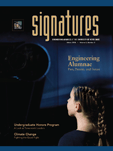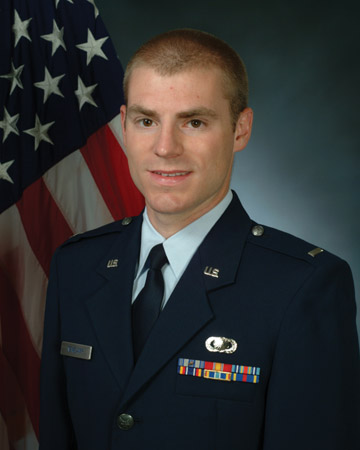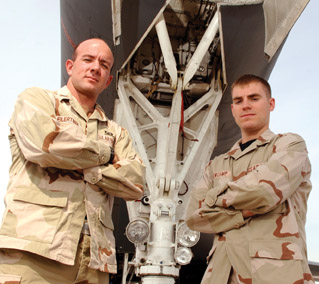
 |
In 2004, Jeffrey Newcamp graduated with Top Cadet honors (#1 cadet in the program) from the Notre Dame Air Force ROTC program. Today, he is a 1st Lt. in the Air Force, has earned his master’s degree from the Air Force Institute of Technology, served overseas, and received numerous awards and commendations, including the Global War on Terrorism Service Medal, the Air Force Achievement Medal (with one Oak Leaf Cluster), and the Air Force Expeditionary Service Ribbon with Gold Border. |
The Side Door of the Basilica?Even people who never attended the University recognize
the words inscribed above the side door of the Basilica: God, Country,
Notre Dame. According to 1st Lt. Jeffrey Newcamp, that’s
all anyone needs to know about Notre Dame and the impact its alumni
can have on the world. Newcamp, who graduated in 2004 with a bachelor’s
degree in aerospace engineering, is doing what he loves and is making
a difference. As an aerospace engineer at the Warner Robins Air Logistics
Center, Robins Air Force Base in Georgia, his primary responsibility
is to provide worldwide engineering support for all C-130 aircraft.
He also provides aircraft battle damage repair (engineering assistance)
for battlefield needs. In 2006, he was deployed to Southwest Asia
where he designed and assisted in the execution of more than 100
nonstandard aircraft repairs at five coalition bases. He describes
battlefield engineering as a fast-paced, real-life test of engineering
skills. “You’re no longer dealing with a problem on paper — in
the field, the airplane needs an accurate repair with no guesswork.
Otherwise, the pilot’s life is on the line.” “Being an engineer carries huge responsibility,
but it also offers huge opportunity,” he says. “I knew
the College of Engineering would be a challenge. ... AME 454 (Propulsion),
taught by Professor Eric Jumper, was one of the toughest classes
I had. The MATLAB programs he required us to write kept me up many
nights. Three years later, I found myself benefitting from his instruction.” One night Newcamp was asked to repair an augmenter
link for an F-16 Falcon engine, which required extensive knowledge
of the operating temperatures and pressures in a typical jet engine.
He says he had confidence in his ability and the repair because of
Jumper’s course. The
plane was flying sorties two days later. On a separate occasion,
Newcamp had to assess the damage (and recommend appropriate action)
regarding a deployed F-15 Eagle that had ingested a foreign object, damaging several of the
rotor blades. After completing the job, he e-mailed Jumper a thank
you for insisting that aerospace engineering students at Notre Dame
learn jet engines. “Being able to put my education into practice
drives my passion for engineering,” says Newcamp, who has numerous
Air Force ROTC friends (fellow graduates of the University) who are
now pilots. While Newcamp acknowledges that the Air Force is one of many outlets for Notre Dame graduates, he stresses that it is definitely a place where engineers can make an impact. “Every day, I touch airplanes. I fix them and help keep the flyers safe. I get to work with amazing professionals who have a common mission (to keep the planes in the air) and I am able to utilize my engineering skills for our country as part of an incredible team.” |
||
Depot liaison engineers with the 379th Expeditionary Maintenance Operations Squadron, 1st Lt. Jeffrey Newcamp, far right, and 2nd Lt. Mark Eilersten pose in front of a B-1 Lancer at a base in Southwest Asia during deployment there in 2006. |
|

